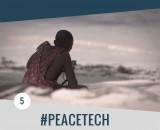Making Their Own Paths to Peace
Afghanistan’s political history and the ongoing violence across the country have directly affected women’s political participation and status in society. By the mid-1990s, the systematic subordination of women resulted in their absolute disappearance from the public sphere. This, however, does not mean that women were not resisting. Often in invisible ways—by turning their homes into girls’ schools and by empowering women through home-based economic activities such as embroidery and carpet weaving—women challenged the ruling system that kept them at home. Other women served as health workers, abiding by the Taliban rule to always be accompanied by a close male relative while reaching out to communities in many parts of the country.
The effects of migration, the denial of fundamental rights, and the psychological toll of long-term war and violence are evident on the faces of Afghan women. However, as great as the consequences of war are on Afghan society in general, and on women in particular, they have turned women into strong and dedicated agents of change—in contrast to the international media’s portrayal of Afghan women as passive, helpless victims who need saving and support. Women’s leadership in local councils is based on their patronage and kinship links to village elites rather than on their technical or formal skills. I also observe that, contrary to the international community’s portrayal of rural Afghanistan being very closed to women’s public roles, depending on the locality and other conditions, Afghan villagers have been quite open to women in the public sphere. However, getting men and women in the same room or truly and fully integrating women’s voices in the village plan is still a challenge, and even though their role is sometimes symbolic, women in the villages now have a space in local governance.
Since 2013, international political and financial support has allowed women to return to the public sphere. But this international support, along with central government programs and projects, must be seen as the means—not the end—in Afghan women’s struggle for gender equality and women’s rights. The key is Afghan women them- selves, their capacity to lead and pioneer the change they envision under the view that rights are gains, not gifts.
Although Afghanistan’s cities are growing rapidly, the majority of the population is still rural. My research over the past three years focuses on how international and national programs and policies have influenced village-level governance structures and norms. How do local communities receive the conditions associated with these interventions? Do they resist or accept them? I looked at a common condition to include women in community development councils (CDCs), village-level councils that many see as a form of local governing structure.[1] These councils identify and prioritize development needs and the projects proposed to meet them. The overall intervention is part of the World Bank’s larger Community Driven Development project known in Afghanistan as the National Solidarity Program (NSP), led by a government ministry and facilitated by nongovernmental organizations (NGOs). I see this as a form of global governance conduct in which both international/transnational and central government institutions and actors strive to establish a set of formal local governance institutions and reconfigure the social relations among the population. The rationales and intentions of each party may differ, but sociopolitical relations change in some way as a result.
I am optimistic about how women are being accepted into the CDCs. These councils identify and prioritize development needs and the projects proposed to meet them. The overall intervention is part of the World Bank’s larger Community Driven Development project known in Afghanistan as the National Solidarity Program (NSP), led by a government ministry and facilitated by nongovernmental organizations (NGOs). Despite high levels of skepticism from many national and international actors about whether women would actually take part in these councils and be accepted, examples of open rejection and resistance to women’s inclusion are very few across the country. The fact that there has not been strong resistance disproves the notion of Afghanistan as a strictly tribal and traditionalist society, static and closed to change. Such acceptance, of course, may not be unrelated to the fact that the interventions bring resources to the community and strengthen the authority of local elites. But the openness to include women on development councils, albeit in a symbolic way in most cases, exists nonetheless.
The women most successfully installed in the local councils have ethnic or kinship ties to the village elites, who, in most cases, lead the councils. Though a high level of politics is also involved in electing male representatives, patronage is a key determinant in allowing women access to the councils and women with no such ties are often excluded. Whether the women can be effective in their representation depends very much on their capacity and position within their community, their level of knowledge and experience, and how courageous they are in speaking their minds. Councils with stronger and more active women members secure better access to resources for women. Councils with women as only symbolic representatives have almost failed to gain any direct support for village women.
Another important factor is the role of facilitating partners and their female social mobilizers who directly work with these women.[2] Najiba Hussaini, a widow elected as CDC deputy in a village in the Yakawlang district of Bamyan, was a refugee in Iran and used to be her community’s female focal point in the camp where she lived. She became deputy chief of the CDC when her village merged with a neighboring village to meet the standard population size criterion for the NSP. The two villages agreed that the positions of chief and deputy should be divided between them based on who won the majority vote. The facilitating partners informed villagers that the deputy CDC post must be filled by a woman. In the ensuing elections, the larger village won the majority vote for the CDC chief position and Hussaini became CDC deputy with the responsibility not only to address the concerns of all women from both villages but also to make sure her home village received a fair share of the resources allocated for each CDC.
As she is articulate in explaining the needs of her community’s women, Najiba is also called to the district assembly to advocate for her council’s needs. She has never been to school and is illiterate but carries her notebook, pen, and mobile everywhere she goes and does not see her illiteracy as a problem. “I can’t read and write, but many do. I save in my mind what people discuss. When it comes to numbers, I ask someone to make notes of numbers in my notebook. Hence, I don’t miss anything,” she says with confidence. However, her CDC has not brought long-term-funded projects to the women of her constituency. She believes this is due to inexperienced facilitating partner staff. “It was my job in the council to explain our needs and priorities,” says Najiba. “But she [the social mobilizer] was not capable of drawing our priorities into a good proposal for addressing our needs. We did not get what we wanted not because of my illiteracy but because of her lack of experience.”
Jamila, a long-time teacher, is CDC deputy in a village in the Behsud district of Nangarhar. She has been a teacher for the past twenty years, including a term under the Taliban regime. She led a number of home-based classes in her village in the late 1990s and early 2000s. As a teacher and family member of her village’s elite majority tribe, Jamila enjoys a higher level of authority. She has been an active member of her village council by bringing in resources and even mobilizing her village men to contribute to building a school for girls and boys in her village. “We found a donor for our school construction, but their condition was that local residents should contribute 20 percent,” she says. “I went house to house in our village and ensured that everyone contributed in some way to raise the 20 percent. The commander in our village contributed seven truckloads of stones for construction material, a businessman paid 10,000Afs, another village elite paid 15000Afs, and the rest of villagers who were unable to pay in cash or kind agreed to take part in labor work. This way we contributed the 20 percent to the overall budget. And the school was built.”
As the stories of Najiba and Jamila illustrate, the key indicator for selecting or electing women to local village councils is not their technical capacity or level of education, but their kinship ties and their ability to take the initiative and lead. The challenges these women faced mainly concerned their experience in working on development projects and how well their mobilizers put together a project that met local women’s needs. Localities and their contexts obviously differ and nothing can be generalized, but in both cases, the women have not taken transformative approaches to challenge the dominant patriarchal system and continue their efforts within conventional gender roles. However, the fact that they are able to step into the room where decisions are made is an important milestone worth recognizing.
Additionally, the high level of openness that local communities have shown in including women in CDCs has been partly a function of the conditions donors have placed on the program, where women’s participation is tied to financial resources. But women can and should seize such opportunities to further strengthen the leadership capacities of women in rural communities. However, men’s lack of resistance to women’s participation in local governance suggests that their inclusion, at this stage, is not a direct threat to the actual rulers of the communities. If and when local women leaders begin to challenge the power of village elites, this scenario could change.
The gains rural Afghan women have made in finding and negotiating their place in local governance are only a small example of their lives. They may not look like women in cities or have the same level of technical capacity and education, but their ability to lead and mobilize women is significant and their contributions should be seen as a strong untapped resource immensely valuable for the future of the country and its local governance relations. International and central government support and commitment are important, but the dedication and readiness of Afghan women over the past decade indicate that they are already making their own paths toward changing the status quo.
[1] Although it has to be pointed out that discussions on the official status of the CDCs as formal local governance institutions are ongoing between the concerned ministries. In a joint policy document titled “Policy for Improving Governance and Development in Districts and Village, May 2013” produced by Ministry of Rural Rehabilitation and Development (MRRD) and Independent Directorate for Local Governance (IDLG) CDCs are recognized as a form of local governance until the constitutionally legitimate village councils are established. Article 13-17 of the policy elaborates on the agreement specifically in this regard. This documents needs to be approved by the Council of Ministers for execution.
[2] The way NSP is operationalized requires NGOs to act as Facilitating Partners. Then each Facilitating Partner sends a pair of Social Mobilisers (male and female) to introduce NSP to villagers, help them with identifying their needs, priorities them and then help them prepare a proposal to get access to the block grant that is provided through this program. In other words, the Social Mobilisers are the “knowledge experts” who play an important role in ensuring that the councils get access to block grants for technically correct right choices.

